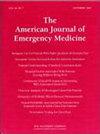基于脑磁共振成像 CT 结构测量的灰白质比率对心脏骤停昏迷患者的预后价值。
IF 2.7
3区 医学
Q1 EMERGENCY MEDICINE
引用次数: 0
摘要
背景:心脏骤停后护理的进步改善了复苏效果,但许多幸存者仍面临严重的神经功能缺损或因脑损伤而死亡。在此,我们提出了一种一致的预后预测方法,利用磁共振成像(MRI)分析灰质和白质所代表的解剖区域,然后将其应用于计算机断层扫描(CT),计算灰白质比率(GWR)。我们将这种新方法与传统方法进行了比较,以验证其预测心脏骤停后复苏患者预后的能力:该研究于 2018 年 1 月至 2022 年 12 月在韩国两家三级大学医院回顾性进行,研究对象包括接受治疗性目标温度管理的成人心脏骤停幸存者。患者在恢复自主循环后2小时内接受脑CT检查,3天内接受脑MRI检查。研究结果为出院时的神经功能状况。统计分析包括接收者操作特征曲线分析和确定预测不良神经功能结果的临界值:在接受检查的 421 名成人心脏骤停昏迷幸存者中,有 51 人符合纳入标准。其中,分别有 33 人和 18 人表现出良好和不良的神经功能预后。对两组幸存者的人口统计学特征和心脏骤停特征进行了比较,结果显示两组之间存在显著差异。对灰质和白质衰减以及 GWR 测量结果的分析显示,结果良好组和结果不佳组之间存在显著差异:我们的研究介绍了一种使用基于核磁共振成像的脑 CT 测量 GWR 的新方法,与传统方法相比,该方法在预测心脏骤停后综合征患者的神经系统预后方面具有更高的准确性。本文章由计算机程序翻译,如有差异,请以英文原文为准。
Prognostic value of gray–white matter ratio measured by brain MRI-based CT structures in comatose patients after cardiac arrest
Background
Post-cardiac arrest care advancements have improved resuscitation outcomes, but many survivors still face severe neurological deficits or death from brain injury. Herein, we propose a consistent prognosis prediction approach using magnetic resonance imaging (MRI) to analyze anatomical regions represented by the gray and white matter, and subsequently apply it on computed tomography (CT) to calculate the gray–white matter ratio (GWR). We compared this novel method with traditional measures to validate its ability to predict the prognosis of patients resuscitated after cardiac arrest.
Methods
Conducted retrospectively at two South Korean tertiary university hospitals from January 2018 to December 2022, the study included adult cardiac arrest survivors treated with therapeutic target temperature management. Patients underwent brain CT within 2 h and brain MRI within 3 days of return of spontaneous circulation. The outcome was the neurological status at discharge. Statistical analyses included receiver operating characteristic curve analysis and determining cutoff values to predict poor neurological outcomes.
Results
Overall, 51 of the 421 adult comatose cardiac arrest survivors examined met the inclusion criteria. Among these, 33 and 18 exhibited good and poor neurological outcomes, respectively. Demographic and cardiac arrest characteristics were compared between the two groups, revealing significant differences. Analyses of gray and white matter attenuation and GWR measurements highlighted significant differences between the good and poor outcome groups.
Conclusion
Our study introduces a novel method for measuring GWR using MRI-based brain CT, demonstrating superior prognostic accuracy in predicting neurological outcomes in patients with post-cardiac arrest syndrome compared to traditional methods.
求助全文
通过发布文献求助,成功后即可免费获取论文全文。
去求助
来源期刊
CiteScore
6.00
自引率
5.60%
发文量
730
审稿时长
42 days
期刊介绍:
A distinctive blend of practicality and scholarliness makes the American Journal of Emergency Medicine a key source for information on emergency medical care. Covering all activities concerned with emergency medicine, it is the journal to turn to for information to help increase the ability to understand, recognize and treat emergency conditions. Issues contain clinical articles, case reports, review articles, editorials, international notes, book reviews and more.

 求助内容:
求助内容: 应助结果提醒方式:
应助结果提醒方式:


